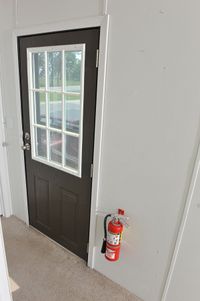Fire extinguisher
| This article may be deleted soon. | ||
|---|---|---|
A fire extinguisher is, in the most common usage, a portable device, usually but not always handheld, for extinguishing undesired fires. Some extinguishers may be on wheeled carts or even truck-mounted, for use on large-scale fires. Built-in equipment using the same principles tend to be called fire suppression systems, as, for example, a Class B system under a restaurant cooking hood. Usage can be informal; most aircraft engines have built-in fire suppression, but a pilot will still order the extinguisher to be triggered. Basic principlesWhile there may be exceptions, the general rules for using an extinguisher are:
ClassesWhile some extinguishers can cope with a wide range of fires, no single type of extinguisher can put out all causes of fire. The basic classification of the National Fire Protection Association defines extinguisher classes as:
For many years, the principle of putting out fires was to break one or more sides of the "fire triangle" consisting of:
More recent insights show there is a fourth component, the propagating combustion wave front, and interfering with the wave front also can stop the fire. Extinguishers may interfere with multiple sides of the fire polygon. Type A water extinguishers both cool the heat level and cut off oxygen. Type ABC extinguishers, using dry powder, primarily separate the fuel and oxidizer. Type D actually start a controlled fire that creates a hard oxide coating over the metal, keeping air from it. Class AWhile the original type A extinguishers were water-based, do not assume that merely because water extinguishers will not work on certain fires, large-scale firefighting equipment, used by trained personnel, cannot be used on other types. Fog nozzles on large hoses, powered by fire engine pumps, can be very effective on oil fires. Soda acidOne of the first types of water-based extinguishers is called "soda-acid", or, especially in a truck-mounted version, "chemical". In a handheld soda acid extinguisher, most of the extinguisher is filled with a water solution of a carbonate or other compound that generates carbon dioxide when mixed with acid. At the top of the extinguisher is a bottle of acid, with a stopper that will fall free when the extinguisher is inverted. There is a handle on the original cylinder bottom, to be used to hold the extinguisher; the hose and nozzle, once the extinguisher is inverted, will be at the base of the cylinder. Guide the nozzle with one hand while holding the cylinder handle. Soda-acid extinguishers need a good deal of maintenance and have other undesirable characteristics; they are becoming rare and deservedly so. As a historical note, "chemical engines" were used in the 19th century, before there were reasonable portable steam or gasoline pumps; an operator manipulated acid and water valves to create a stream from a fire engine. These are totally obsolete. Pressurized waterManual pumpEspecially for fighting outdoor wildfires, it is quite common to see a five-gallon tank rigged to be worn as a backpack. A hose connects the tank to a nozzle assembly, which has a sliding grip that, when moved back and forth, sucks water from the tank and sprays it from the nozzle. A great advantage is that the tank can be refilled from ordinary water sources, but it is tiring to use; the water alone will weigh 40 pounds, and the tank is usually strong metal. Class BClass B extinguishers exclude air from burning liquids, but contain little or no water that could spread burning oil. Carbon dioxideCarbon dioxide extinguishers are quite effective, also cooling the fire, but have the major disadvantage that they displace oxygen to an extent that they cannot be safely used, in confined areas, without breathing equipment. FoamNew chemicalsClass CClass DSupply and maintenance of extinguishersTechniques of professional useIn a fire brigade, the truck (or ladder) companies have, as a first responsibility, rescue. Search teams often have one (or more) firefighter with forcible entry tools and another with a Class A extinguisher; the "irons and can" team. Such personnel, however, are trained, preferably to an instinctive level, to recognize doors with substantial fire behind them, and never to force a door and risk an explosive result. The purpose of the "can" is to provide a minimal access for the rescuing firefighters to reach the victim. Obviously, if the firefighter has self-contained breathing apparatus, the rules about ensuring air supply change. |
||
